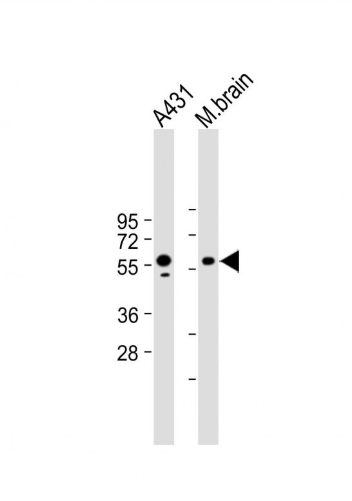
Mouse Anti-PINK1 antibody
PINK1_HUMAN; PTEN Induced Putative Kinase 1; PTEN-Induced Putative Kinase Protein 1; BRPK; Serine/Threonine-Protein Kinase PINK1, Mitochondrial; Parkinson Disease (Autosomal Recessive) 6; Protein Kinase BRPK; EC 2.7.11.1; PARK6;
View History [Clear]
Details
Product Name PINK1 Chinese Name 丝氨酸/苏氨酸蛋白激酶PINK1单克隆抗体 Alias PINK1_HUMAN; PTEN Induced Putative Kinase 1; PTEN-Induced Putative Kinase Protein 1; BRPK; Serine/Threonine-Protein Kinase PINK1, Mitochondrial; Parkinson Disease (Autosomal Recessive) 6; Protein Kinase BRPK; EC 2.7.11.1; PARK6; literatures Research Area Signal transduction Kinases and Phosphatases Mitochondrion Immunogen Species Mouse Clonality Monoclonal Clone NO. 5C6 React Species (predicted: Human, Mouse, ) Applications WB=1:200-1000 IHC-P=1:100-500 IHC-F=1:50-100 ICC=1:25 IF=1:25 (Paraffin sections need antigen repair)
not yet tested in other applications.
optimal dilutions/concentrations should be determined by the end user.Theoretical molecular weight 63kDa Cellular localization cytoplasmic Mitochondrion Form Liquid Concentration 1mg/ml immunogen Recombinant human PINK1 protein Lsotype IgG Purification affinity purified by Protein G Buffer Solution 0.01M TBS(pH7.4) with 1% BSA, 0.03% Proclin300 and 50% Glycerol. Storage Shipped at 4℃. Store at -20 °C for one year. Avoid repeated freeze/thaw cycles. Attention This product as supplied is intended for research use only, not for use in human, therapeutic or diagnostic applications. PubMed PubMed Product Detail This gene encodes a serine/threonine protein kinase that localizes to mitochondria. It is thought to protect cells from stress-induced mitochondrial dysfunction. Mutations in this gene cause one form of autosomal recessive early-onset Parkinson disease. [provided by RefSeq, Jul 2008]
Function:
Protects against mitochondrial dysfunction during cellular stress by phosphorylating mitochondrial proteins. Involved in the clearance of damaged mitochondria via selective autophagy (mitophagy) by mediating activation and translocation of PRKN . Targets PRKN to dysfunctional depolarized mitochondria through the phosphorylation of MFN2 . Activates PRKN in 2 steps: (1) by mediating phosphorylation at 'Ser-65' of PRKN and (2) mediating phosphorylation of ubiquitin, converting PRKN to its fully-active form . Required for ubiquinone reduction by mitochondrial complex I by mediating phosphorylation of complex I subunit NDUFA10 (By similarity).
Subunit:
Interacts with PRKN. Interacts with FBXO7. Forms a complex with PRKN and PARK7.
Subcellular Location:
Localizes mostly in mitochondrion and the 2 proteolytic processed fragments of 55 kDa and 48 kDa localize mainly in cytosol.
Tissue Specificity:
Highly expressed in heart, skeletal muscle and testis, and at lower levels in brain, placenta, liver, kidney, pancreas, prostate, ovary and small intestine. Present in the embryonic testis from an early stage of development.
Post-translational modifications:
Autophosphorylation at Ser-228 and Ser-402 is essential for Parkin/PRKN recruitment to depolarized mitochondria.
Two shorter forms of 55 kDa and 48 kDa seem to be produced by proteolytic cleavage and localize mainly in cytosol.
Similarity:
Belongs to the protein kinase superfamily. Ser/Thr protein kinase family.
SWISS:
Q9BXM7
Gene ID:
65018
Database links:Entrez Gene: 65018 Human
Entrez Gene: 68943 Mouse
SwissProt: Q9BXM7 Human
SwissProt: Q99MQ3 Mouse
Product Picture
References (0)
No References
Bought notes(bought amounts latest0)
No one bought this product
User Comment(Total0User Comment Num)
- No comment



 +86 571 56623320
+86 571 56623320
 +86 18668110335
+86 18668110335

